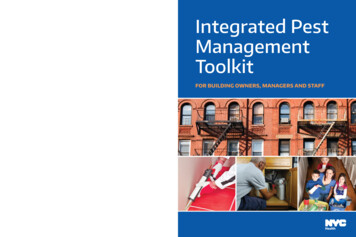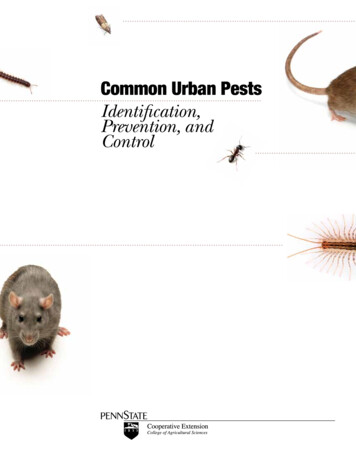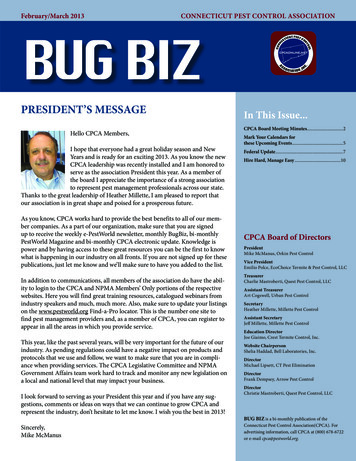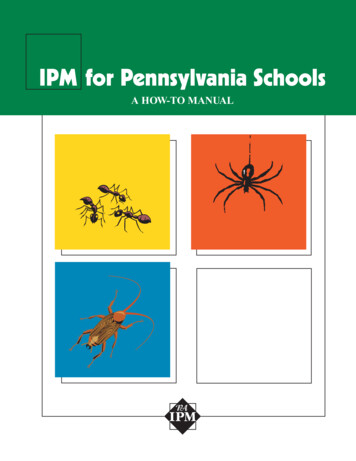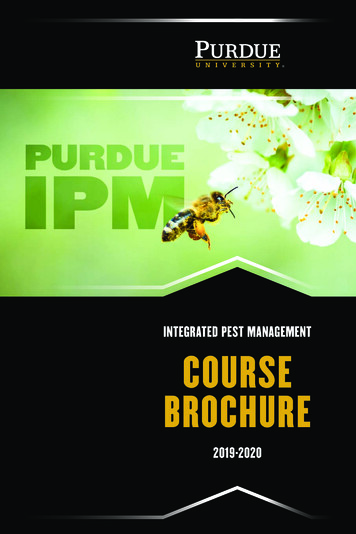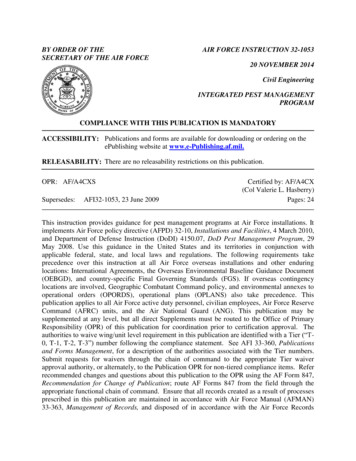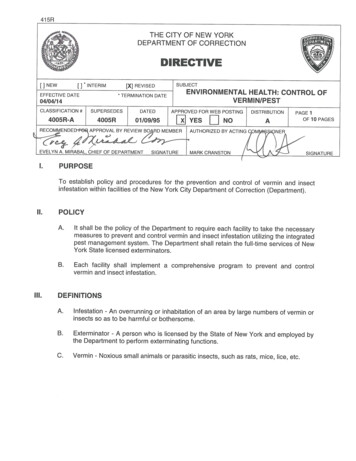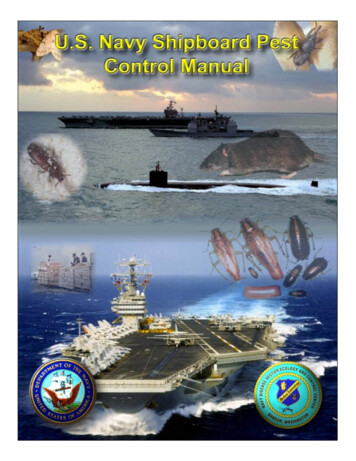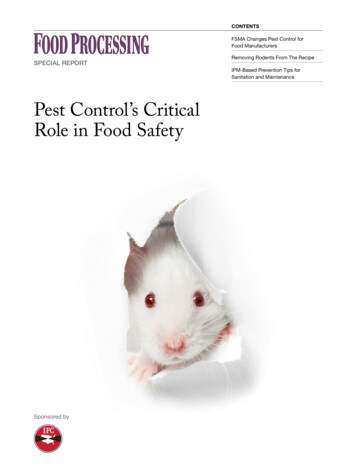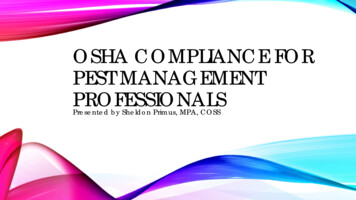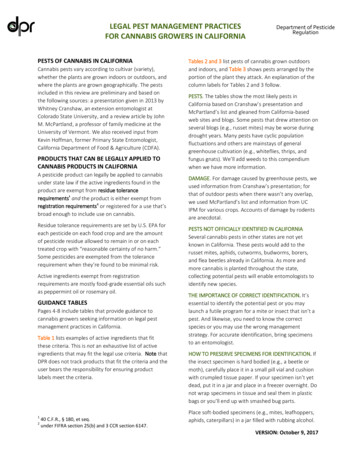
Transcription
LEGAL PEST MANAGEMENT PRACTICESFOR CANNABIS GROWERS IN CALIFORNIAPESTS OF CANNABIS IN CALIFORNIACannabis pests vary according to cultivar (variety),whether the plants are grown indoors or outdoors, andwhere the plants are grown geographically. The pestsincluded in this review are preliminary and based onthe following sources: a presentation given in 2013 byWhitney Cranshaw, an extension entomologist atColorado State University, and a review article by JohnM. McPartland, a professor of family medicine at theUniversity of Vermont. We also received input fromKevin Hoffman, former Primary State Entomologist,California Department of Food & Agriculture (CDFA).PRODUCTS THAT CAN BE LEGALLY APPLIED TOCANNABIS PRODUCTS IN CALIFORNIAA pesticide product can legally be applied to cannabisunder state law if the active ingredients found in theproduct are exempt from residue tolerance1requirements and the product is either exempt from2registration requirements or registered for a use that’sbroad enough to include use on cannabis.Residue tolerance requirements are set by U.S. EPA foreach pesticide on each food crop and are the amountof pesticide residue allowed to remain in or on eachtreated crop with “reasonable certainty of no harm.”Some pesticides are exempted from the tolerancerequirement when they’re found to be minimal risk.Active ingredients exempt from registrationrequirements are mostly food-grade essential oils suchas peppermint oil or rosemary oil.GUIDANCE TABLESPages 4-8 include tables that provide guidance tocannabis growers seeking information on legal pestmanagement practices in California.Table 1 lists examples of active ingredients that fitthese criteria. This is not an exhaustive list of activeingredients that may fit the legal use criteria. Note thatDPR does not track products that fit the criteria and theuser bears the responsibility for ensuring productlabels meet the criteria.140 C.F.R., § 180, et seq.2under FIFRA section 25(b) and 3 CCR section 6147.Department of PesticideRegulationTables 2 and 3 list pests of cannabis grown outdoorsand indoors, and Table 3 shows pests arranged by theportion of the plant they attack. An explanation of thecolumn labels for Tables 2 and 3 follow.PESTS. The tables show the most likely pests inCalifornia based on Cranshaw’s presentation andMcPartland’s list and gleaned from California-basedweb sites and blogs. Some pests that drew attention onseveral blogs (e.g., russet mites) may be worse duringdrought years. Many pests have cyclic populationfluctuations and others are mainstays of generalgreenhouse cultivation (e.g., whiteflies, thrips, andfungus gnats). We’ll add weeds to this compendiumwhen we have more information.DAMAGE. For damage caused by greenhouse pests, weused information from Cranshaw’s presentation; forthat of outdoor pests when there wasn’t any overlap,we used McPartland’s list and information from UCIPM for various crops. Accounts of damage by rodentsare anecdotal.PESTS NOT OFFICIALLY IDENTIFIED IN CALIFORNIASeveral cannabis pests in other states are not yetknown in California. These pests would add to therusset mites, aphids, cutworms, budworms, borers,and flea beetles already in California. As more andmore cannabis is planted throughout the state,collecting potential pests will enable entomologists toidentify new species.THE IMPORTANCE OF CORRECT IDENTIFICATION. It’sessential to identify the potential pest or you maylaunch a futile program for a mite or insect that isn’t apest. And likewise, you need to know the correctspecies or you may use the wrong managementstrategy. For accurate identification, bring specimensto an entomologist.HOW TO PRESERVE SPECIMENS FOR IDENTIFICATION. Ifthe insect specimen is hard bodied (e.g., a beetle ormoth), carefully place it in a small pill vial and cushionwith crumpled tissue paper. If your specimen isn’t yetdead, put it in a jar and place in a freezer overnight. Donot wrap specimens in tissue and seal them in plasticbags or you’ll end up with smashed bug parts.Place soft-bodied specimens (e.g., mites, leafhoppers,aphids, caterpillars) in a jar filled with rubbing alcohol.VERSION: October 9, 2017
arthropods by planting strips or borders of cover crops(e.g., California buckwheat) and insectary plants—especially those in the carrot, mustard, and sunflowerfamilies (Pickett & Bugg, 1998).Include written information such as where on the plantyou found the specimen, the general location of theplant, and date captured. Note original color andtexture, since these will change once you immerse thespecimen in alcohol. Also helpful are photographs ofthe specimen in its original habitat.LEGAL PESTICIDES. These are covered above in theTable 1 description and are exempt from residuetolerance requirements and either exempt fromregistration requirements or registered for a use that isbroad enough to include use on cannabis.IPM PRACTICES. Most of these are standard practicesfor pests on plants other than cannabis. For moredetailed explanations, see information compiled by theUniversity of California Statewide IPM Program (UCIPM) at www.ipm.ucdavis.edu. You can enter a pestname in the search box (e.g., cutworm) and read aboutIPM practices for the pest on crops other than cannabis.For cannabis grown indoors, go to the UC IPM homepage, click on Agricultural Pests and scroll down thealphabetical list until you reach ornamental nurseries.REFERENCESCranshaw, Whitney. 2013. Challenges andopportunities for pest management of medicalmarijuana in Colorado. Presentation.McPartland, J.M. 1996. Cannabis pests. J. Internatl.Hemp Assoc. 3(2): 49, 52–55.Some practices were excluded because they apply tonearly all of the pests. For example, when targetingaphids, whiteflies, and thrips on crops grown outdoors,growers can attract predaceous and parasiticPickett, C.H. & R.L. Bugg, eds. 1998. EnhancingBiological Control: Habitat management to promotenatural enemies of agricultural pests. UC Press,Oakland, Calif.2
Table 1. Active ingredients that are exempt from residue tolerance requirementsa and eitherexempt from registration requirementsb or registered for a use broad enough to include use oncannabis. [updated on September 22, 2017]ACTIVE INGREDIENTPEST OR DISEASEa1azadirachtinaphids, whiteflies, fungus gnats, leafminers, cutworms2Bacillus amyloliquefaciens strain D7473Bacillus subtilis QSTa1root and crown diseases, powdery mildew, Botrytisa1a4root diseases, powdery mildew4Bacillus thuringiensis5Bacillus thuringiensis6Beauveria bassiana7Burkholderia spp. strain A3968capsaicin ( capsicum oleoresin)9castor oil10cinnamon, cinnamon oil11citric acida4subsp. kurstakimoth larvae (e.g., cutworms, budworms, borers)subsp. israelensisfly larvae (e.g., fungus gnats)a5whiteflies, aphids, thripsa4mites, leafhoppers, aphids, whiteflies, thrips, moth larvaearepellent (insects vertebrates); mites, leafhoppers,whiteflies, thrips, moth larvaebrepellent (moles, voles, gophers)bslugs and snails, mites, leafhoppers, aphids, whiteflies,moth larvaebbacteria, fungi, mites, insects12cloves and clove oil13corn oil14cottonseed oil15garlic and garlic oil16geraniol17Gliocladium virensbbacteria, fungibfungi, mites, insectsbfungi, mites, insectsbmites, leafhoppers, aphids, whiteflies, moth larvaebfungi, rodent repellent, mites, insectsa2root diseasesa18horticultural oils (petroleum oil)mites, aphids, whiteflies, thrips, powdery mildew19insecticidal soaps (potassium salts of fatty acids)20iron phosphate , sodium ferric EDTA21Isaria fumosorosea22neem oil23peppermint, peppermint oil24potassium bicarbonate ; sodium bicarbonate25potassium silicate26potassium sorbateaaa5aaphids, whiteflies, cutworms, budwormsslugs and snails*mites, aphids, whiteflies, thripsamites, powdery mildewaabbbacteria, fungi, mites, leafhoppers, aphids, whiteflies, mothlarvaeapowdery mildewpowdery mildew, mites, aphidsfungi, mites, insects3
a27predatory nematodes28putrescent whole egg solids29rosemary, rosemary oil30sesame and sesame oil31sodium chloride32soybean oil33Reynoutria sachalinensis extract34sulfur35Trichoderma harzianum36thyme oilabfungus gnatsbsquirrel, rabbit, and deer repellentbbacteria, fungi, leafhoppers, aphids, whiteflies, moth larvaebmites, leafhoppers, aphids, whiteflies, moth larvaeb[minor active ingredient in some fungicide and insecticideformulations]bmites, insectsa3apowdery mildewmites, flea beetlesa2broot diseasesmites, leafhoppers, aphids, whiteflies, moth larvae140 CFR (Code of Federal Regulations)FIFRA §25(b) and 3 CCR §6147 [FIFRA the FederalInsecticide, Fungicide, and Rodenticide Act;CCR California Code of Regulations]Bacterial-based fungicideFungal-based fungicide3Plant-based fungicide4Bacterial-based insecticide5Fungal-based insecticide2*Isaria fumosorosea was formerly Paecilomycesfumosoroseus4
Table 2. PEST MANAGEMENT PRACTICES FOR CANNABIS GROWN OUTDOORSIPM PRACTICESPESTDAMAGE(monitoring; cultural, physical,mechanical, biological)PESTICIDESMITES & INSECTStwo-spotted spider mitesTetranychus urticae(and other Tetranychidae)Suck plant sap; stippleleavesbroad mitesPolyphagotarsonemus latusDistort leaves andbuds Keep dust down by hosingoff plants (if dust is aproblem)Release predatory mitesneem oil, horticultural oil Inspect plants; disinfest ordispose of infested plants— Release predatory mites andsixspotted thripsrusset mitesAculops spp.Suck plant sap; killleaves and flowers Release predatory mitescrickets (field & house)Eat seedlings Use floating row covers ortermitesEat roots Flood nestsleafhoppersSuck plant sap;weaken plants Encourage natural enemieswhitefliesTrialeurodes vaporariorum,Bemisia tabaci, B. argentifoliiSuck plant sap;weaken plants Hang up yellow sticky cards Use reflective plastic mulchazadirachtin, horticulturaloil, insecticidal soaps,rosemary peppermint oils,Beauveria bassianathripsHeliothrips haemorrhoidalis,Frankliniella occidentalis,Thrips tabaciStipple and scarleaves; vector viruses Hang up yellow or blue stickyhorticultural oil, insecticidalsoaps, rosemary peppermint oils, Beauveria bassianaSuck plant sap;weaken plants Hang up yellow sticky cardsaphidsMyzus persicae, Aphis fabaeleafminersLiriomyza spp.—cones on individual plantsby planting nectar sourcescards Bore into roots andleavesneem oil, horticultural oil,sulfur(alates)Hose off plants Remove older infested leaves Use biocontrol: releaseDiglyphus parasitoids5—horticultural oil or insecticidal soaps for nymphsazadirachtin, horticulturaloil, insecticidal soaps,Beauveria bassianaazadirachtin
IPM PRACTICESLEPIDOPTERAPESTcutwormsAgrotis ipsilon,Spodoptera exigua(Noctuidae)DAMAGE Use pheromone traps toEat seedlings detect adults.Remove weeds, which serveas a reservoir for cutwormsand other noctuids Shake plants to dislodgeEat flowering budsflea beetles(Chrysomelidae)Bore into stems(grubs); feed onseedlings and leavesof larger plants(adults) Use reflective mulches Plant trap crops (e.g., radishBore into stems Use parasitic nematodesEat young sprouts andseeds Double wrap a 3’-tall chickenroof rats, Rattus rattuswood rats, Neotoma spp.Strip bark from stemsto build nests Tunnel throughplanting areas; feed onplants; gnaw onirrigation lines Install underground fencingpocket gophers,Thomomys spp.Columbian black-tailed deer,Odocoileus hemionuscolumbianusKnock over plants;leave dander,droppings, and ticksbehind Install deer fencingblack bears, Ursus americanaKnock over plants Install electric fencingCOLEOOPTERAbudwormsHelicoverpa zea(Noctuidae)scarab grubs(Scarabaeidae)PESTICIDES(monitoring; cultural, physical,mechanical, biological) larvaeRemove infested budsPlant corn as trap cropVegetative stage only: UseBacillus thuringiensiskurstaki if egg-laying adultsfound, insecticidal soap;azadirachtinVegetative stage only: UseBacillus thuringiensiskurstaki, insecticidal soapsulfuror Chinese mustard)—possibly other beetles)MAMMALSmice (e.g., house mice) wire fence around plantsTrap (minus rodenticides)Mount barn owl boxesrodenticides*(hardware cloth or ¾” meshpoultry wire)Mount barn owl boxes——* If using a rodenticide always read and follow the label and check to make sure that the target rodent is listed. Secondgeneration anticoagulant products (contain the active ingredients brodifacoum, bromadiolone, difenacoum, anddifethialone) are DPR-restricted materials not labeled for field use and should never be used in or around cannabiscultivation sites. Permits for the use of DPR-restricted materials will not be issued to cannabis cultivators. Any federallyrestricted use pesticide must be applied by a certified applicator consistent with the registered labeling.6
Table 3. PEST MANAGEMENT PRACTICES FOR CANNABIS GROWN INDOORS(e.g., greenhouses, sheds, and grow rooms)IPM PRACTICESPESTDAMAGE(monitoring; cultural, physical,mechanical, biological)PESTICIDESDISEASESpowdery mildewSphaerotheca macularisGrow on leaves aswhite and gray powdery patches Use fans to improve airpythium root rotsPythium spp.Attack root tips andworsens when plantsgrow in wet soil Avoid hydroponiccirculationproduction or wet soilconditionshorticultural oil; neem oil;sodium bicarbonate, potassiumbicarbonate; Bacillus subtilisIncorporate biocontrol agentsinto root-growing media (e.g.,Gliocladium virens, Trichodermaharzianum, Bacillus subtilis)MITES & INSECTS Disinfest cuttings beforetwo-spotted spider mitesTetranychus urticae(and other Tetranychidae)Suck plant sap; stippleleaves introducing to growingareaRelease predatory mites(Amblyseius spp.,Phytoseiulus persimilis), orlacewings (Chrysoperiaspp.)neem oil, horticultural oil, sulfur Inspect plants; disinfest ordispose of infested plantsRelease predatory mites(Amblyseius spp.) and sixspotted thripsbroad mitesDistort leaves andbuds leafhoppersSuck plant sap;weaken plants Encourage natural enemieswhitefliesTrialeurodes vaporariorum,Bemisia tabaci, B. argentifoliiSuck plant sap;weaken plantsby planting nectar sources Hang up yellow sticky cards Use biocontrol: Amblyseiusswirskii, Encarsia formosa,Delphastus catalinae,Steinernea feltiaehorticultural oil or insecticidalsoaps for nymphsazadirachtin, Beauveriabassiana, cinnamon oil,horticultural oil Sterilize soil and potsbefore growingthripsHeliothrips haemorrhoidalis,Frankliniella occidentalis,Thrips tabaci Hang up yellow or blueStipple and scarleaves; vector virusessticky cards Use biocontrolStratiolaelaps scimitus,Amblyseius cucumeris,Amblyseius swirskii, Oriusinsidious7azadirachtin, horticultural oil,insecticidal soaps, rosemary peppermint oils, Beauveriabassiana
IPM PRACTICESPESTDAMAGE(monitoring; cultural, physical,mechanical, biological)PESTICIDES Dispose of weakenedinfested plants Mix in sharp soilrice root aphidRhopalosiphum rufiabdominalisFeed on roots; stuntand weaken plantsamendments such asdiatomaceous earthBeauveria bassiana Use biocontrol:Stratiolaelaps scimitus,Dalotia coriaria,Steinernema feltiae Avoid overwatering Use growing media thatdark-winged fungus gnats(Diptera: Sciaridae)Bradysia spp.Damage roots andstunt plant growthdeters gnat development Hang up yellow sticky cards Use biocontrol:Stratiolaelaps scimitus,Dalotia coriaria,Steinernema feltiae8Bacillus thuringiensis israelensis(BTI); predatory nematodes;azadirachtin soil drenches
Table 2. PEST MANAGEMENT PRACTICES FOR CANNABIS GROWN OUTDOORS . PEST DAMAGE IPM PRACTICES (monitoring; cultural, physical, mechanical, biological) PESTICIDES MITES & INSECTS. two-spotted spider mites. Tetranychus urticae (and other Tetranychidae) Suck plant sap; stipple . leaves Keep dust down by hosing off plants (if dust is a problem)

